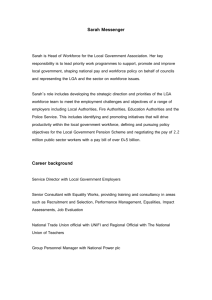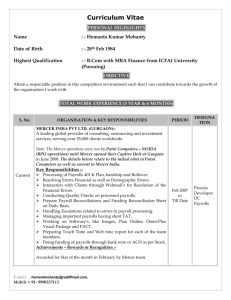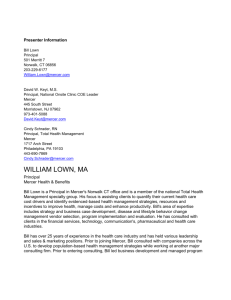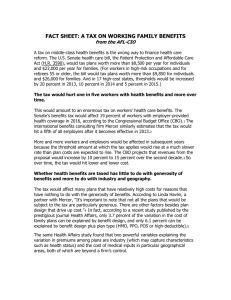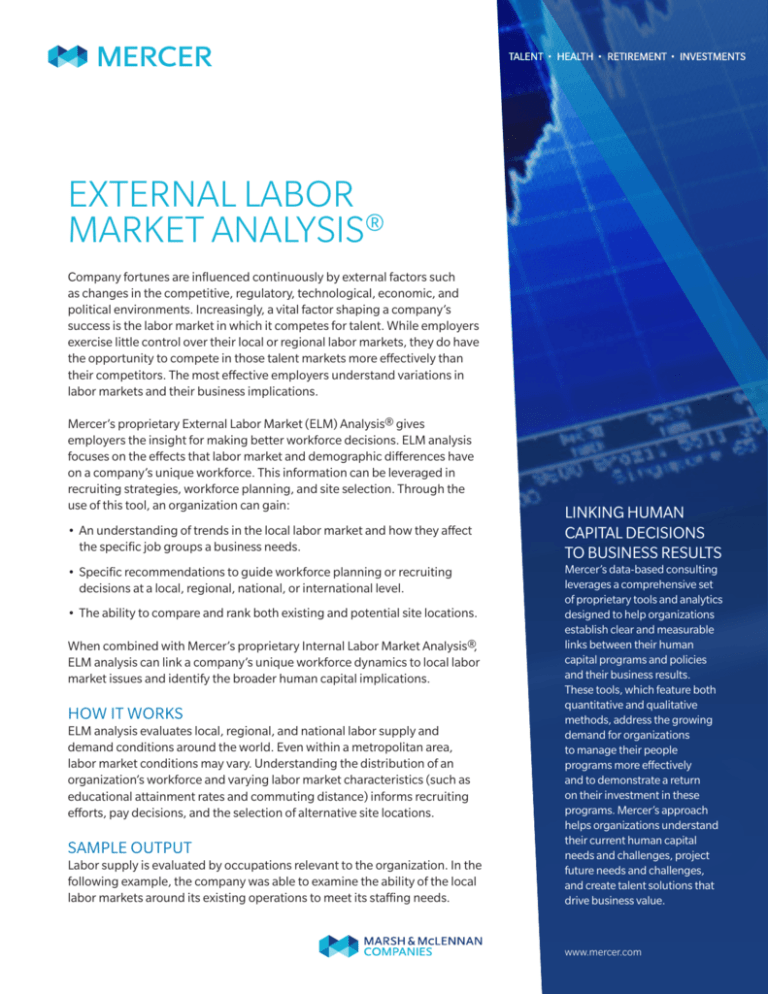
EXTERNAL LABOR
MARKET ANALYSIS®
Company fortunes are influenced continuously by external factors such
as changes in the competitive, regulatory, technological, economic, and
political environments. Increasingly, a vital factor shaping a company’s
success is the labor market in which it competes for talent. While employers
exercise little control over their local or regional labor markets, they do have
the opportunity to compete in those talent markets more effectively than
their competitors. The most effective employers understand variations in
labor markets and their business implications.
Mercer’s proprietary External Labor Market (ELM) Analysis® gives
employers the insight for making better workforce decisions. ELM analysis
focuses on the effects that labor market and demographic differences have
on a company’s unique workforce. This information can be leveraged in
recruiting strategies, workforce planning, and site selection. Through the
use of this tool, an organization can gain:
• An understanding of trends in the local labor market and how they affect
the specific job groups a business needs.
• Specific recommendations to guide workforce planning or recruiting
decisions at a local, regional, national, or international level.
• The ability to compare and rank both existing and potential site locations.
When combined with Mercer’s proprietary Internal Labor Market Analysis®,
ELM analysis can link a company’s unique workforce dynamics to local labor
market issues and identify the broader human capital implications.
HOW IT WORKS
ELM analysis evaluates local, regional, and national labor supply and
demand conditions around the world. Even within a metropolitan area,
labor market conditions may vary. Understanding the distribution of an
organization’s workforce and varying labor market characteristics (such as
educational attainment rates and commuting distance) informs recruiting
efforts, pay decisions, and the selection of alternative site locations.
SAMPLE OUTPUT
Labor supply is evaluated by occupations relevant to the organization. In the
following example, the company was able to examine the ability of the local
labor markets around its existing operations to meet its staffing needs.
LINKING HUMAN
CAPITAL DECISIONS
TO BUSINESS RESULTS
Mercer’s data-based consulting
leverages a comprehensive set
of proprietary tools and analytics
designed to help organizations
establish clear and measurable
links between their human
capital programs and policies
and their business results.
These tools, which feature both
quantitative and qualitative
methods, address the growing
demand for organizations
to manage their people
programs more effectively
and to demonstrate a return
on their investment in these
programs. Mercer’s approach
helps organizations understand
their current human capital
needs and challenges, project
future needs and challenges,
and create talent solutions that
drive business value.
www.mercer.com
Recruiting efforts were targeted at the local, regional, or national level —
depending upon which labor market could offer access to a labor pool
sufficient for replacement and growth.
City A
City B
City C
City D
Civil engineers
Engineering managers
Other engineering workers
Manufacturing workers
Mechanics and maintenance workers
Accountants and HR professionals
Information technology workers
Local labor pool designation key:
Alternative sources needed
Replacement hires only
Expansion possible
Not all labor markets are equally favorable for startup, relocation, or
expansion. In addition to addressing labor and real estate costs, this
company evaluated current and future labor availability, bilingual language
capabilities, and time zone coverage. Location A surpassed others in
suitability for relocation from a labor perspective.
Weights from executive
meeting and interviews
Higher scores are more favorable
(100 = national average)
Ranking Summary
Location Location
A
B
Location Location
C
D
Location
E
Weight
Criteria
40%
Current labor availability
131
123
124
137
117
20%
Labor and real estate costs
105
109
97
60
123
10%
Future labor availability
138
136
142
142
128
7%
Size of the bilingual workforce
177
160
132
205
133
5%
Additional time zone coverage
supporting 24/7 operations
90
100
100
110
100
4%
Competitive employers present
41
55
69
20
69
4%
Part-time aptitude of workforce
129
123
137
147
110
4%
Attractiveness to relocating workers
110
90
90
110
90
3%
General education quality of local schools 88
110
130
64
118
3%
Labor union power
126
120
118
91
120
Total
122
118
117
117
116
Copyright 2013 Mercer LLC. All rights reserved.
For more information
about ELM or any of
Mercer’s proprietary
analytical tools, contact
your local Mercer office or
visit www.mercer.com/
workforceanalytics.
11139A-HC-020713








